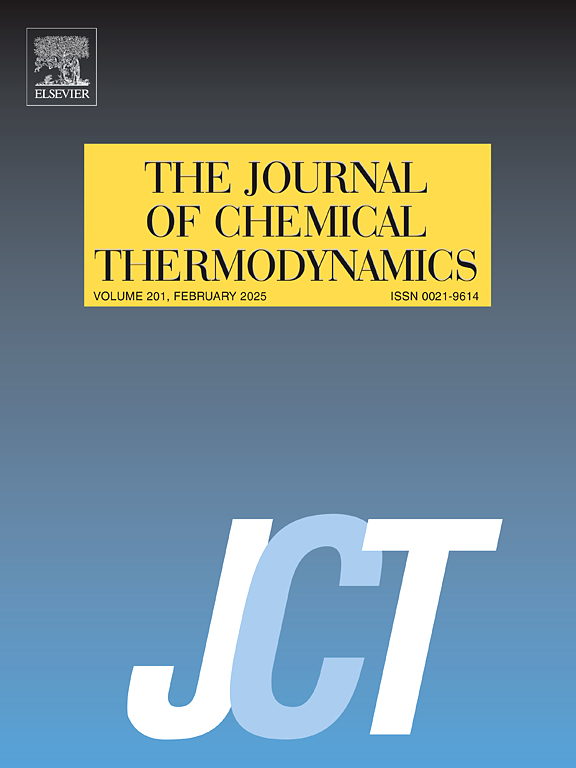[4-甲基-2-戊醇+ 2-甲氧基乙醇,或2-(2-甲氧基乙氧基)乙醇,或2-{2-(2-甲氧基乙氧基)乙氧基}乙醇]在不同温度下的体积、传输和声学特性
IF 2.2
3区 工程技术
Q3 CHEMISTRY, PHYSICAL
引用次数: 0
摘要
在T = (298.15, 303.15, 308.15) K下,在压力p = 0.10 MPa下,测量了4-甲基-2-戊醇与烷氧乙醇的纯组分和二元混合物,即2-甲氧基乙醇、2-(2-甲氧基乙氧基)乙醇和2-{2-(2-甲氧基乙氧基)乙氧基}乙醇的密度(ρ)、粘度(η)和声速(u)。热力学性质,如超额摩尔体积(VmE),超额摩尔等熵压缩性(Ks,mE),在声速偏差(uD),在粘度偏差(Δη)和超额吉布斯自由能活化粘性流动(ΔG * E)已计算使用实验数据。相似分子和不同分子之间的相互作用可以用过量或偏差特性来描述。用Redlich-Kister多项式方程来关联超差和偏差特性的值。此外,密度值用于计算偏摩尔体积(V¯m,i)。已经考虑了各种半经验关系来关联测量的粘度,包括Grunberg-Nissan, Tamura-Kurata, Hind等人,Katti-Chaudhri, McAllister(三体相互作用)模型,herc - brewer和McAllister(四体相互作用)模型。此外,采用PFP (Prigogine-Flory-Patterson)理论计算了VmE值。从分子间相互作用的角度对所得结果进行了讨论。本文章由计算机程序翻译,如有差异,请以英文原文为准。
Volumetric, transport and acoustic properties of [4-methyl-2-pentanol + 2-methoxyethanol, or 2-(2-methoxyethoxy)ethanol, or 2-{2-(2-methoxyethoxy)ethoxy}ethanol] at varying temperatures
Density (), viscosity () and speed of sound (u) of pure components and binary mixtures of 4-methyl-2-pentanol with alkoxyethanols viz., 2-methoxyethanol, 2-(2-methoxyethoxy)ethanol and 2-{2-(2-methoxyethoxy)ethoxy}ethanol have been measured at T = (298.15, 303.15, 308.15) K over the entire range of composition at pressure p = 0.10 MPa. Thermodynamic properties such as excess molar volume (), excess molar isentropic compressibility (), deviation in speed of sound (), deviation in viscosity (Δη) and excess Gibbs free energy of activation for viscous flow () have been calculated using experimental data. The interaction between like and unlike molecules can be described using the excess or deviation properties. The Redlich-Kister polynomial equation has been used to correlate the values of the excess and deviation properties. Further, density values were used to calculate partial molar volumes (). Various semi-empirical relations have been considered to correlate the measured viscosities, including Grunberg-Nissan, Tamura-Kurata, Hind et al., Katti-Chaudhri, McAllister (three body interaction) model, Heric-Brewer and McAllister (four body interaction) model. In addition, Prigogine-Flory-Patterson (PFP) theory is used to obtain the values. The results obtained are discussed in term of intermolecular interactions taking place between the molecules of liquid components under investigation.
求助全文
通过发布文献求助,成功后即可免费获取论文全文。
去求助
来源期刊

Journal of Chemical Thermodynamics
工程技术-热力学
CiteScore
5.60
自引率
15.40%
发文量
199
审稿时长
79 days
期刊介绍:
The Journal of Chemical Thermodynamics exists primarily for dissemination of significant new knowledge in experimental equilibrium thermodynamics and transport properties of chemical systems. The defining attributes of The Journal are the quality and relevance of the papers published.
The Journal publishes work relating to gases, liquids, solids, polymers, mixtures, solutions and interfaces. Studies on systems with variability, such as biological or bio-based materials, gas hydrates, among others, will also be considered provided these are well characterized and reproducible where possible. Experimental methods should be described in sufficient detail to allow critical assessment of the accuracy claimed.
Authors are encouraged to provide physical or chemical interpretations of the results. Articles can contain modelling sections providing representations of data or molecular insights into the properties or transformations studied. Theoretical papers on chemical thermodynamics using molecular theory or modelling are also considered.
The Journal welcomes review articles in the field of chemical thermodynamics but prospective authors should first consult one of the Editors concerning the suitability of the proposed review.
Contributions of a routine nature or reporting on uncharacterised materials are not accepted.
 求助内容:
求助内容: 应助结果提醒方式:
应助结果提醒方式:


